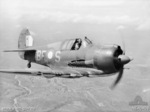Boomerang
| Country | Australia |
| Manufacturer | Commonwealth Aircraft Corporation |
| Primary Role | Fighter |
| Maiden Flight | 29 May 1942 |
Contributor: C. Peter Chen
ww2dbaseAustralia became involved in the Pacific War in Dec 1941, and the Royal Australian Air Force was ill-prepared to face the superior Japanese fighter aircraft. Taking the Pratt & Whitney Twin Wasp engines, the most powerful engines available to Australians at the time (license built by the Commonwealth Aircraft Corporation), Lawrence Wackett and Fred David designed the CA-12 Boomerang aircraft based upon the Wirraway trainer aircraft starting on 21 Dec 1941.
ww2dbaseWackett and David designed the CA-12 Boomerang fighters as small fighters that were maneuverable enough to engage faster Japanese fighters in dogfights. They were also designed to carry ample firepower and armor plating. On 2 Feb 1942, the RAAF ordered 105 CA-12 Mark I aircraft before seeing the flight of the prototype, which would not take place until May. The first batch of CA-12 Boomerang fighters were disappointing, however; the heavy armament and armor deprived the fighters of the maneuverability particularly in higher altitudes. The CA-13 variant began production not long after CA-12, but the improvements were not significant.
ww2dbaseWhen the Boomerang fighters entered service, in addition to the poor performance, Spitfire fighters from the United Kingdom and P-40 Kittyhawk fighters from the United States had already been ordered by the RAAF; additionally, P-47 Thunderbolt and P-51 Mustang fighters were on order from the United States. As a result, No. 83 and No. 85 Squadrons RAAF and their Boomerang fighters were limited to home defense only, and only No. 84 Squadron was sent to the front lines of New Guinea to participate in combat. Pilots of the No. 84 Squadron complained of inadequate speed and poor high altitude performance, and switched to P-40 Kittyhawk fighters only eight months after receiving their Boomerang fighters.
ww2dbaseAs No. 4 and No. 5 Squadrons RAAF received their Boomerang fighters, however the pilots discovered they were excellent close support aircraft. In New Guinea, these Boomerang fighters performed bombing, strafing, and artillery spotting missions with great success.
ww2dbaseTo address the performance issues of the CA-12 and CA-13 Boomerang fighters, efforts were spent on the CA-14 variant design, with the primary change being the adaptation of more powerful engines. Initially, Wright Cyclone R-2600 and then Wright Cyclone R-2800 engines were chosen, but in the end, the CA-14 variant aircraft made use of the same Pratt & Whitney Twin Wasp engines as the CA-12, but General Electric B-2 turbo-superchargers were added to increase the power output. By Jul 1943, CA-14A aircraft were able to surpass the CA-12 design in top speed and altitude, however, this improved design never reached production.
ww2dbaseIn all, between 1942 and 1945, 105 CA-12, 95 CA-13, and 49 CA-19 (reconnaissance aircraft with vertical cameras) were built for a total of 249.
ww2dbaseSource: Wikipedia.
Last Major Revision: Jun 2008
Boomerang Timeline
| 29 May 1942 | The Commonwealth CA-12 Boomerang fighter made its maiden flight, only fourteen weeks after its design had been approved and an initial order for 105 machines placed. |
SPECIFICATIONS
CA-12
| Machinery | One Pratt & Whitney R-1830 Twin Wasp radial engine rated at 1,200hp |
| Armament | 2x20mm Hispano or CAC cannons, 4x7.7mm Browning machine guns |
| Crew | 1 |
| Span | 10.97 m |
| Length | 7.77 m |
| Height | 2.92 m |
| Wing Area | 20.90 m² |
| Weight, Empty | 2,437 kg |
| Weight, Loaded | 3,492 kg |
| Speed, Maximum | 491 km/h |
| Rate of Climb | 14.90 m/s |
| Service Ceiling | 8,800 m |
| Range, Normal | 1,500 km |
Photographs
 |  |  |  |
Did you enjoy this article or find this article helpful? If so, please consider supporting us on Patreon. Even $1 per month will go a long way! Thank you. Share this article with your friends: Stay updated with WW2DB: |
Visitor Submitted Comments
All visitor submitted comments are opinions of those making the submissions and do not reflect views of WW2DB.
- » Wreck of USS Edsall Found (14 Nov 2024)
- » Autumn 2024 Fundraiser (7 Nov 2024)
- » Nobel Peace Prize for the Atomic Bomb Survivors Organization (11 Oct 2024)
- » Wreck of USS Stewart/DD-224 Found (2 Oct 2024)
- » See all news
- » 1,150 biographies
- » 337 events
- » 43,917 timeline entries
- » 1,241 ships
- » 350 aircraft models
- » 207 vehicle models
- » 374 weapon models
- » 123 historical documents
- » 260 facilities
- » 470 book reviews
- » 28,541 photos
- » 432 maps
General Douglas MacArthur at Leyte, 17 Oct 1944
Please consider supporting us on Patreon. Even $1 a month will go a long way. Thank you!
Or, please support us by purchasing some WW2DB merchandise at TeeSpring, Thank you!
18 Jan 2011 03:39:56 AM
My son is slowly rebuilding No 90 in Sydney.
Any information regarding parts would be most appreciated, & I would be pleased to hear from any restorers wanting to trade/sell parts.